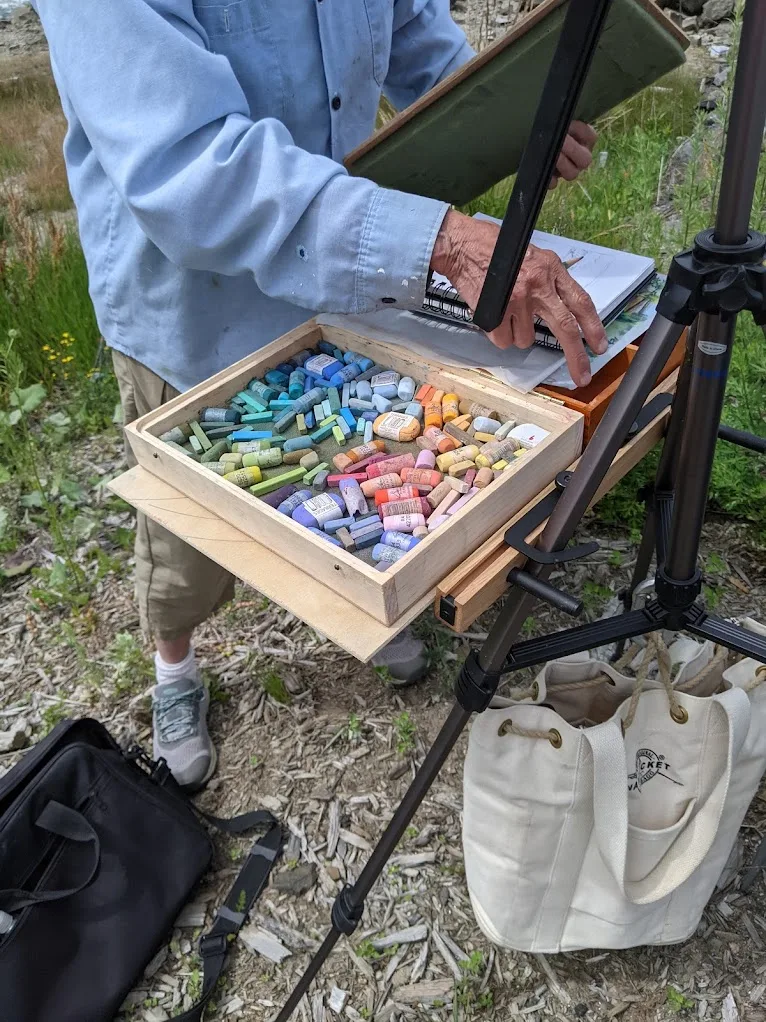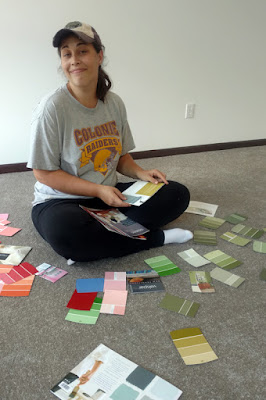Being stingy with art supplies will cost you more in the long run.
 |
| Terrie’s rig is handmade but very solid. There are many ways to solve the pochade box question, which is why I hesitate to recommend one. |
The discussion started with a student confessing that he didn’t mix enough different greens for his painting of a rill riffling through a forest. “I didn’t want to waste paint,” he said. “Paint is expensive.” Instead, he wasted paint and time.
“Paint like you’re rich,” his classmate told him.
Turns out that was advice from my student and friend Becky Bense.
 |
| French easels may be heavy, but at least they work. |
I should have known. Becky regularly chides me for my use of cheap watercolor paper for demos. While the paint seems to flow off the brush fine, it dries as if I’d painted with a typewriter. My justification is that I’m trying to demonstrate a principle, not create art. Also, I have a lot of it lying around; it was on sale and I succumbed to the temptation. But I’ve never painted anything good on it and I never will.
If I were a student, I’d be terribly frustrated by the results. Perhaps enough so that I would believe I couldn’t paint and would stop trying. I certainly wouldn’t learn much.
 |
| Then there’s always the picnic-table option. |
At my Sedona workshop, two students had pochade boxes from Meeden, a low-end art supply vendor. They fill a niche for the casual hobbyist, but their products are not robust enough for serious painting.
One of these boxes was fatally flawed; its mount was not strong enough to hold the box on the tripod. Had Ed Buonvecchio not lent the student his old field easel, she’d have been unable to paint at all. She’d flown in from Hawaii, rented a car, reserved a room, bought top-end paints and brushes—and was stymied by this weakest link.
I provide detailed supply lists for my classes, but don’t specify a brand of pochade box, as there are so many excellent ones out there. It never occurred to me that anyone would buy a Meeden box. No serious art supply stores sell their products.
 |
| Minnie Brown combined the French easel with the picnic table option at Sedona. |
But if you search Amazon for ‘pochade box’, Meeden is the brand that comes up first. And the world of Google throws us another curve. Because I’d just looked at Meeden boxes on Amazon, when I searched for Easy L Pochade Box (a brand I recommend without reservation) I got a series of ads that led me straight back to Meeden. There’s convenience in online shopping, but a lot of hucksterism, too.
But back to the paint itself—it’s a false economy to not squeeze out a proper amount, to paint on bad substrates, or with lousy brushes. It always ends up costing more in time, materials, and lost opportunities. In fact, none of us are rich enough to be stingy with our art supplies.
Speaking of classes, I have a new session starting next week on Zoom. The key to being a good artist is working at it consistently. For busy people, that’s often the hardest part. We meet for three hours weekly to dissect and practice a key element of painting such as design, color, perspective, foliage, value masses, or brushwork. And as the above discussion indicates, a lot of learning goes on from student to student, too.
I’ve taught on Zoom since the start of COVID. A big reason these classes work so well is the support and encouragement my students give each other. You listen, adapt, critique and think through problems as a group, and we are all better for it.
ZOOM morning Session
We meet on Tuesdays from 10 AM to 1 PM EST, on the following dates:
April 12, 19, 26
May 3, 10, 17
ZOOM evening Session
We meet on Mondays from 6 to 9 PM EST, on the following dates:
April 11, 18, 25
May 2, 9, 16
The fee for either six-week session is $235.
All media are welcome. More information can be found here, or just email me.



